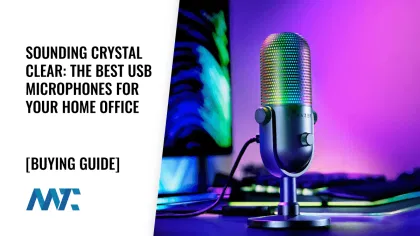
The rise of remote work has highlighted the importance of high-quality audio. A good USB microphone can make all the difference, whether you’re attending virtual meetings, recording podcasts, or chatting with colleagues. But with so many options available, how do you choose the right one for your home office? This guide breaks down the different types of microphones, key features, and popular recommendations to help you sound your best.
Table of Contents
While professional studios often rely on XLR microphones paired with audio interfaces, this guide focuses on the convenience and simplicity of USB and USB-C microphones. These plug-and-play marvels bypass external pre-amps and perfectly suit home offices and on-the-go recording. Whether you’re leading a virtual meeting, recording a podcast, or streaming your latest gameplay, USB microphones offer a streamlined solution for capturing high-quality audio without the added complexity.
Microphone Styles: Finding Your Perfect Fit
Arm-Mounted Microphones
These microphones attach to an adjustable arm, allowing for greater flexibility in positioning. This helps to achieve optimal sound capture and reduce unwanted noise. Not all boom arms are created equal, though. Many are flimsy and hang the microphone in the way of your camera. Higher-quality microphones often weigh more, so a sturdy mount is necessary.
- Pros: It is highly adjustable, improves sound quality by minimizing vibrations and getting closer to the source, and keeps your desk clear.
- Cons: It can be more expensive than desktop microphones and requires some desk space for the arm.
I’ve opted for a low-profile microphone arm in my home office that mounts the microphone outside the camera view. It’s built incredibly well and even has a chamber for hiding your cables.
Desktop Microphones
These microphones sit directly on your desk, often with a built-in stand. They are convenient and space-saving, making them popular for most home office setups.
- Pros: Easy to use, compact, affordable options available.
- Cons: It can pick up noises like your keyboard or tapping on the desk and has limited flexibility in positioning.
Portable Microphones
Compact and designed for portability, these microphones are perfect for those who are always on the go or have limited desk space.
- Pros: Small and lightweight, easy to carry around, often come with built-in noise cancellation.
- Cons: May have a limited feature set compared to desktop or arm-mounted options.
Key Features that Define a Great USB Microphone
Understanding the technical specifications of a USB microphone can feel like navigating a foreign language. But fear not! These key features, often hidden within product descriptions, hold the secrets to unlocking crystal-clear audio:
Polar Patterns: Controlling the Sound Field
Imagine your microphone as a sonic compass, guiding the direction from which it captures sound. This is known as its polar pattern. Choosing the right polar pattern is crucial for optimizing your audio, especially in a home office environment where unwanted noise can be a constant challenge. Here are the most common types:
- Cardioid: This heart-shaped pattern captures sound primarily from the front of the microphone, making it ideal for recording a single voice and minimizing background noise. It’s the go-to choice for most home office setups, podcasts, and streaming.
- Bidirectional: As the name suggests, this pattern picks up sound from both the front and back of the microphone. This is particularly useful for recording interviews or two-person conversations where both voices need to be captured clearly.
- Omnidirectional: This pattern captures sound equally from all directions. While it might seem versatile, it’s less ideal for home offices as it can pick up unwanted ambient noise. However, it can be useful for conference calls with multiple participants in the same room.
Frequency Response: Capturing the Nuances of Your Voice
Think of frequency response as the microphone’s hearing range. Measured in Hertz (Hz), it indicates the range of sound frequencies the microphone can accurately capture. A wider frequency response generally translates to a richer and more natural sound, capturing the subtle nuances of your voice.
For spoken word and vocal recordings, a frequency response range of around 50Hz to 15kHz is generally sufficient. However, if you’re recording music or instruments, you might need a wider range to capture the full spectrum of sounds.
Noise Cancellation: Silencing the Unwanted
When WFH, unwanted noise can come from keyboard clicks, fan hum, traffic outside, or even the neighbor’s lawnmower. Microphones with built-in noise cancellation technology actively filter out these distractions, ensuring your voice remains clear and prominent.
Look for features like digital signal processing (DSP) or noise-canceling algorithms that intelligently identify and reduce background noise without compromising the quality of your voice. One note is that a high-quality, cardioid microphone typically doesn’t require noise canceling.
Gain Control: Finding Your Sweet Spot
Gain control allows you to adjust the microphone’s sensitivity, essentially how loud it hears your voice. This is crucial for achieving optimal recording levels and preventing distortion. Increasing the gain can boost the signal if your voice sounds too quiet or distant. Conversely, reducing the gain can help prevent distortion if your voice is too loud or causing clipping.
Other Features:
- Mute Button: A quick and convenient way to silence your microphone when needed, preventing accidental interruptions or unwanted noise. Buttons on a mic are often much easier to tap than trying to click on a mute button on the user interface (UI) of your meeting software.
- Headphone Jack: You can monitor your audio in real time, ensuring you sound exactly as intended.
- Shock Mount: Isolates the microphone from vibrations, minimizing unwanted noise caused by bumps or movements.
- Pop Filter: Reduces plosive sounds (from p and b sounds) for cleaner recordings.
Considering the different microphone styles and key technology features, you can choose the best USB microphone to elevate your home office audio experience and ensure you sound professional and clear in every virtual interaction.